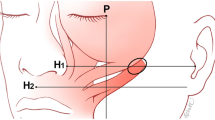Abstract
Purpose
Direct access to the zygomatic branch of the facial nerve in the parotid is less invasive and more selective than first dissecting the nerve trunk and then finding the branches. The aim of this study was to confirm the point of reference on the skin which would give direct access to the zygomatic branch for the orbicularis oculi muscle. The skin reference point studied was on the intertragic notch/external canthus line, 2.5 cm in front of the intertragic notch.
Methods
Ten fresh cadavers, and thus 20 sides of faces were dissected. The zygomatic branch of the facial nerve innervating the orbicularis oculi muscle was accessed directly. The dissection was extended to temporofacial and cervicofacial branches and then to the trunk of the facial nerve by a retrograde path in the parotid.
Results
Twenty dissections of the parotid area confirmed the validity of the anatomical reference point of the zygomatic branch for the orbicularis oculi muscle considered.
Conclusions
The simplicity and reliability of this landmark is important in clinical practice and has numerous potential applications in surgery for rehabilitation of facial paralysis associated with VII healthy and VII affected neurorraphies, in facial paresis for superneurotizations and in traumatology.






Similar content being viewed by others
References
Frey M, Giovanoli P, Michaelidou M (2006) Functional upgrading of partially recovered facial palsy by cross-face nerve grafting with distal end-to-side neurorrhaphy. Plast Reconstr Surg 117(2):597–608
Furnas DW (1965) Landmarks for the trunk and the temporofacial division of the facial nerve. Br J Surg 52:694–696
Gosain AK, Sewall SR, Yousif NJ (1997) The temporal branch of the facial nerve: How reliably can we predict its path? Plast Reconstr Surg 99:1224–1233
Hwang K, Cho HJ, Chung IH (2004) Pattern of the temporal branch of the facial nerve in the upper orbicularis oculi muscle. J Craniofac Surg 15(3):373–376
Jaeger MR, Braga-Silva J, Gehlen D, Pereira-Filho Gde A, Zettler CG, de Souza MA et al (2011) End-to-end versus end-to-side motor and sensory neurorraphy in the repair of acute muscle denervation. Ann Plast Surg 67(4):391–396
Krayenbuhl N, Isolan GR, Hafez A, Yasargil MG (2007) The relationship of the fronto-temporal branches of the facial nerve to the fascias of the temporal region: a literature review applied to practical anatomic dissection. Neurosurg Rev 30:8–15
Labbé D (1997) Lengthening of temporalis myoplasty and reanimation of lips. Technical notes. Ann Chir Plast Esthet 42(1):44–47
Labbé D, Hamel M, Bénateau H (2003) Lengthening of temporalis myoplasty and transfacial nerve graft (VII–V). Technical note Ann Chir Plast Esthet 48(1):31–35
Pather N, Osman M (2006) Landmarks of the facial nerve: implications for parotidectomy. Surg Radiol Anat 28(2):170–175
Pélissier P, Riahi R, Casoli V, Martin D, Baudet J (2001) Terminal-lateral nerve anastomososes. Preliminary clinical report of two cases. Ann Chir Plat Esthet 46(2):129–133
Rovak JM, Cederna PS, Kuzon WM Jr (2001) Terminolateral neurorraphy: a review of the literature. J Reconstr Microsurg 17(8):615–624
Sundine MJ, Quan EE, Saglam O, Dhawan V, Quesada PM, Ogden L et al (2003) The use of end-to-side nerve grafts to reinnervate the paralyzed orbicularis oculi muscle. Plast Reconstr Surg 111(7):2255–2264
Tayfur V, Edizer M, Magden O (2010) Anatomic bases of superficial temporal artery and temporal branch of facial nerve. J Craniofac Surg 21(6):1945–1947
Touré G, Vacher C (2010) Relations of the facial nerve with the retromandibular vein: anatomic study of 132 parotid glands. Surg Radiol Anat 32(10):957–961
Viterbo F, Amr AH, Stipp EJ, Reis FJ (2009) End-to-side neurorrhaphy: past, present, and future. Plast Reconstr Surg 124(6 Suppl):e351–e358
Viterbo F, Teixeira E, Hoshino K, Padovani CR (1998) End-to-side neurorraphy with and without perineurium. Sao Paulo Med J 116(5):1808–1814
Conflict of interest
All authors, their immediate family, and any research foundation with which they are affiliated did not receive any financial payments or other benefits from any commercial entity, related to the subject of this article.
Author information
Authors and Affiliations
Corresponding author
Rights and permissions
About this article
Cite this article
Chatellier, A., Labbé, D., Salamé, E. et al. Skin reference point for the zygomatic branch of the facial nerve innervating the orbicularis oculi muscle (anatomical study). Surg Radiol Anat 35, 259–262 (2013). https://doi.org/10.1007/s00276-012-1023-y
Received:
Accepted:
Published:
Issue Date:
DOI: https://doi.org/10.1007/s00276-012-1023-y




